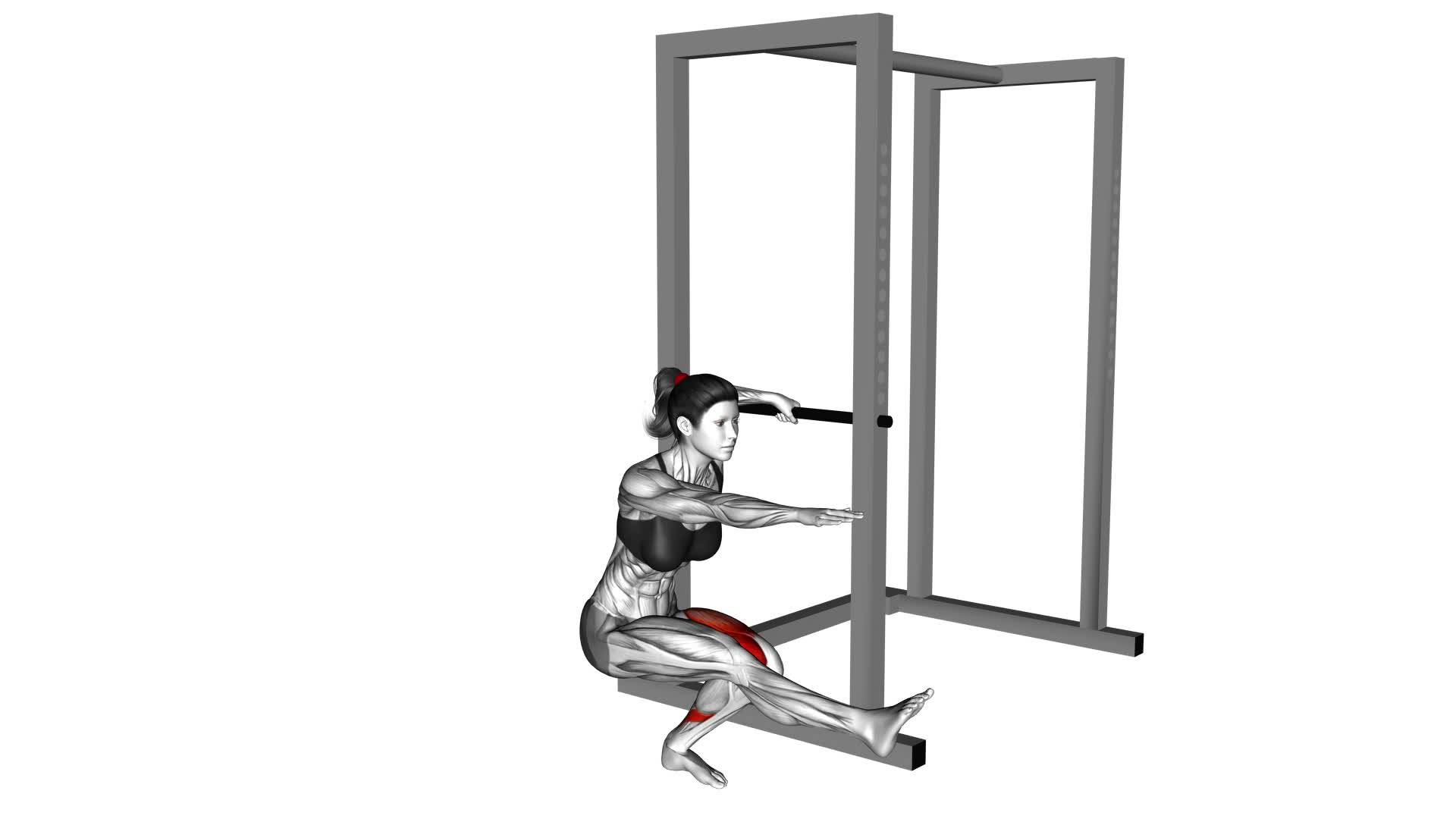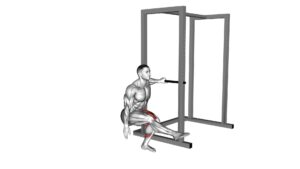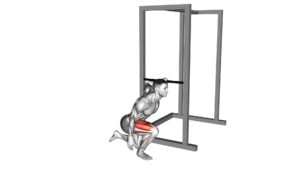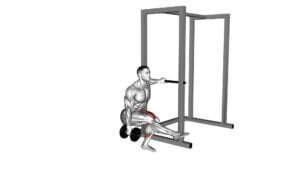Single Leg Squat With Support (Female) – Video Exercise Guide & Tips

In this video exercise guide, you'll learn how to perform the single leg squat with support. This exercise offers numerous benefits for your lower body strength and stability. By using proper form and technique, you can target your glutes, quads, and hamstrings effectively.
Watch This Exercise Video
If you're a beginner, we've got modifications to help you get started. For those looking to take it up a notch, advanced variations and progressions are included.
Stay safe by following our tips and avoiding common mistakes. Let's get squatting!
Key Takeaways
- Single leg squats with support target glutes, quads, and hamstrings effectively.
- They enhance lower body strength and stability.
- Single leg squats with support improve overall functional fitness and increase muscle activation in the lower body.
- They also help prevent falls and injuries and engage core muscles.
Benefits of Single Leg Squat With Support
Discover the numerous advantages you can experience by incorporating the single leg squat with support into your workout routine. This exercise is highly effective in terms of muscle activation, particularly in the lower body. By performing the single leg squat with support, you engage and strengthen the quadriceps, hamstrings, glutes, and calves. These muscles play a crucial role in everyday activities such as walking, running, and climbing stairs, so strengthening them can greatly enhance your overall functional fitness.
In addition to muscle activation, the single leg squat with support also improves balance and stability. By standing on one leg and lowering your body down into a squat position, you challenge your body's ability to maintain equilibrium. This not only strengthens the muscles responsible for keeping you upright but also enhances proprioception, which is your body's awareness of its position in space. Improved balance and stability can help prevent injuries, especially in older adults who are more prone to falls.
Now that you understand the benefits of the single leg squat with support, let's move on to the next section, where we'll discuss proper form and technique to ensure you maximize the benefits and minimize the risk of injury.
Proper Form and Technique
To ensure maximum benefits and minimize the risk of injury, let's focus on the proper form and technique for performing the single leg squat with support.
Follow these tips to ensure you're performing the exercise correctly:
- Maintain Proper Alignment:
- Stand tall with your feet hip-width apart and your core engaged.
- Keep your chest lifted and your spine neutral throughout the movement.
- Avoid leaning forward or rounding your back.
- Control Your Descent:
- Slowly lower your body by bending your knee and hip, while keeping your weight on your supporting leg.
- Aim to lower yourself until your thigh is parallel to the ground.
- Avoid dropping too quickly or going too low, as this can strain your knees and compromise form.
- Engage Your Glutes:
- As you push through your supporting leg to return to the starting position, focus on squeezing your glutes.
- This won't only help you maintain stability but also enhance the effectiveness of the exercise.
Common Mistakes to Avoid:
- Allowing your knee to cave inward:
- Ensure that your knee stays in line with your toes throughout the movement.
- Rounding your shoulders:
- Keep your shoulders back and down, maintaining good upper body posture.
- Using momentum:
- Avoid using momentum to complete the exercise.
- Focus on controlled and deliberate movements.
Modifications for Beginners
For beginners, start by using a support for added stability during the single leg squat. This modification is especially helpful for those who are new to this exercise or have difficulty with balance. By using a support, such as a chair or wall, you can ensure that you maintain proper form and reduce the risk of injury.
To perform the single leg squat with support, stand with your feet hip-width apart and place one hand on the support. Lift one foot slightly off the ground and maintain a straight posture. Slowly lower yourself down into a squat position, keeping your core engaged and your knee directly over your ankle. Push through your heel to return to the starting position.
As a beginner, you may face common challenges such as lack of strength and balance. Using a support will help you to gradually build strength in your legs and improve your balance over time. Remember to start with a comfortable range of motion and gradually increase the depth of your squat as you become more comfortable and confident.
Keep practicing and with time, you'll be able to perform the single leg squat without support.
Advanced Variations and Progressions
As you progress in your single leg squat journey, you can explore advanced variations and progressions to challenge your strength and balance even further. These advanced progressions require greater muscle activation and control, taking your single leg squat to the next level.
Here are three advanced variations and progressions to consider:
- Pistol Squat: This advanced variation involves performing a single leg squat without any support. It requires exceptional strength, stability, and balance. Start by extending one leg in front of you while keeping the other leg firmly planted on the ground. Slowly lower yourself into a squat position while maintaining control and balance. This exercise targets your quadriceps, hamstrings, glutes, and core muscles.
- Weighted Single Leg Squat: To further challenge your strength, you can add weights to your single leg squat. Hold a dumbbell or kettlebell in your hands or use a barbell across your shoulders. The added resistance increases muscle activation and helps develop greater strength in your lower body.
- Depth Jumps: This advanced progression introduces plyometric movements into your single leg squat routine. Start by stepping off a box or platform and immediately land on one leg in a single leg squat position. Focus on landing softly and absorbing the impact with control. Depth jumps enhance explosive power and improve overall lower body strength.
Safety Tips and Common Mistakes to Avoid
Ensure proper form and minimize the risk of injury by following these safety tips and avoiding common mistakes while performing the single leg squat with support exercise.
When performing this exercise, it's important to maintain control and stability throughout the movement. One common mistake to avoid is allowing your knee to collapse inward. This puts unnecessary stress on your knee joint and can lead to injury. To prevent this, focus on keeping your knee in line with your toes as you squat down.
Another common mistake is leaning too far forward or backward. This can throw off your balance and strain your lower back. To maintain proper form, keep your chest lifted and your torso upright throughout the exercise.
Additionally, make sure to use a stable support, such as a chair or wall, to assist with balance and prevent falls.
Lastly, it's important to listen to your body and not push yourself too hard. If you experience any pain or discomfort, stop the exercise and consult with a qualified fitness professional.
Frequently Asked Questions
How Many Calories Can I Burn by Doing Single Leg Squats With Support?
You can burn a significant amount of calories by doing single leg squats with support. Proper form and technique are essential to maximize the calorie burn. Focus on maintaining balance and stability while performing the exercise.
To modify or progress the exercise, you can adjust the height of the support or add weights. Remember to consult a fitness professional for guidance on proper form and to determine the appropriate modifications for your fitness level.
Will Single Leg Squats With Support Help Me Improve My Balance?
Single leg squats with support can help improve your balance. By engaging the muscles in your legs and core, these variations of single leg squats challenge your stability and coordination.
The benefits of single leg squats include strengthening the muscles in your lower body, improving your overall balance and stability, and enhancing functional movement patterns.
Incorporating single leg squats with support into your fitness routine can be an effective way to target these specific areas and enhance your balance.
Can I Incorporate Single Leg Squats With Support Into My Regular Strength Training Routine?
Yes, you can definitely incorporate single leg squats with support into your regular strength training routine. By adding them to your HIIT workout, you can work on improving your balance and leg strength.
For beginners, you can modify the exercise by using a lower support or starting with a smaller range of motion. Remember to maintain proper form and gradually increase the difficulty as you progress.
This will help you get the most out of your single leg squat with support exercises.
How Often Should I Do Single Leg Squats With Support to See Results?
To see results from single leg squats with support, it's important to be consistent and patient. The time it takes to see results can vary depending on factors like your fitness level and training intensity. However, with regular practice, you can start noticing improvements in strength, balance, and stability within a few weeks.
The benefits of single leg squats with support include targeting your leg muscles, improving overall lower body strength, and enhancing functional movement patterns.
Are There Any Specific Muscles That Single Leg Squats With Support Target More Than Traditional Squats?
Single leg squats with support target specific muscles more than traditional squats. These exercises primarily engage your quadriceps, hamstrings, glutes, and core muscles. By focusing on one leg at a time, you increase the activation and strength of these muscle groups.
The benefits of single leg squats include improved balance, stability, and coordination. They also help to develop functional strength that translates into daily activities and sports performance.
Conclusion
In conclusion, the single leg squat with support is a highly effective exercise that targets the lower body muscles while improving balance and stability.
By maintaining proper form and technique, individuals can optimize the benefits of this exercise.
Beginners can start with modifications to gradually build strength and stability, while advanced variations can challenge those who are looking for more intensity.
Remember to prioritize safety and avoid common mistakes to maximize the effectiveness of this exercise.

Author
Years ago, the spark of my life’s passion ignited in my mind the moment I stepped into the local gym for the first time. The inaugural bead of perspiration, the initial endeavor, the very first surge of endorphins, and a sense of pride that washed over me post-workout marked the beginning of my deep-seated interest in strength sports, fitness, and sports nutrition. This very curiosity blossomed rapidly into a profound fascination, propelling me to earn a Master’s degree in Physical Education from the Academy of Physical Education in Krakow, followed by a Sports Manager diploma from the Jagiellonian University. My journey of growth led me to gain more specialized qualifications, such as being a certified personal trainer with a focus on sports dietetics, a lifeguard, and an instructor for wellness and corrective gymnastics. Theoretical knowledge paired seamlessly with practical experience, reinforcing my belief that the transformation of individuals under my guidance was also a reflection of my personal growth. This belief holds true even today. Each day, I strive to push the boundaries and explore new realms. These realms gently elevate me to greater heights. The unique combination of passion for my field and the continuous quest for growth fuels my drive to break new ground.







